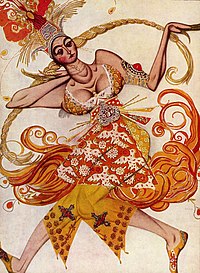| L'Oiseau de feu The Firebird | |
|---|---|
 Costume sketch for the titular Firebird by Léon Bakst, 1910 | |
| Native title | French: L'Oiseau de feu Russian: Жар-птица, romanized: Zhar-ptitsa |
| Choreographer | Michel Fokine |
| Music | Igor Stravinsky |
| Based on | Russian folk tales |
| Premiere | 25 June 1910 Palais Garnier |
| Original ballet company | Ballets Russes |
| Design | Aleksandr Golovin (sets) Léon Bakst (costumes) |
The Firebird (French: L'Oiseau de feu; Russian: Жар-птица, romanized: Zhar-ptitsa) is a ballet and orchestral concert work by the Russian composer Igor Stravinsky. It was written for the 1910 Paris season of Sergei Diaghilev's Ballets Russes company; the original choreography was by Michel Fokine, who collaborated with Alexandre Benois and others on a scenario based on the Russian fairy tales of the Firebird and the blessing and curse it possesses for its owner. It was first performed at the Opéra de Paris on 25 June 1910 and was an immediate success, catapulting Stravinsky to international fame and leading to future Diaghilev–Stravinsky collaborations including Petrushka (1911) and The Rite of Spring (1913).
The Firebird's mortal and supernatural elements are distinguished with a system of leitmotifs placed in the harmony dubbed "leit-harmony". Stravinsky intentionally used many specialist techniques in the orchestra, including ponticello, col legno, flautando, glissando, and flutter-tonguing. Set in the evil immortal Koschei's castle, the ballet follows Prince Ivan, who battles Koschei with the help of the magical Firebird.
Stravinsky later created three concert suites based on the work: in 1911, ending with the "Infernal Dance"; in 1919, which remains the most popular today; and in 1945, featuring significant reorchestration and structural changes. Other choreographers have staged the work with Fokine's original choreography or created entirely new productions using the music, some with new settings or themes. Many recordings of the suites have been made; the first was released in 1928, using the 1911 suite. A film version of the popular Sadler's Wells Ballet production, which revived Fokine's original choreography, was produced in 1959.